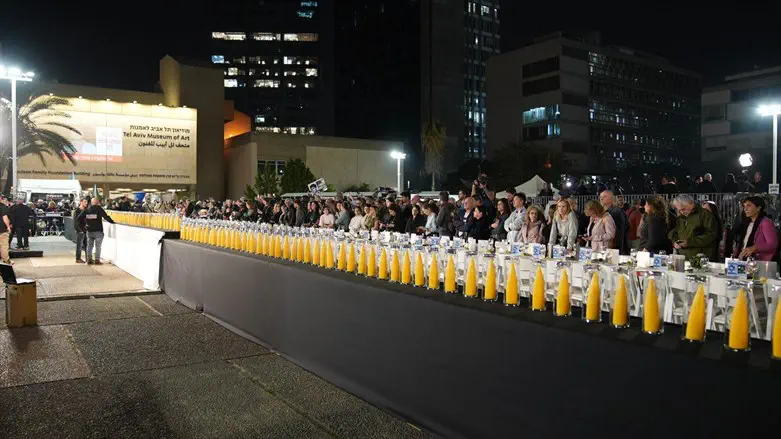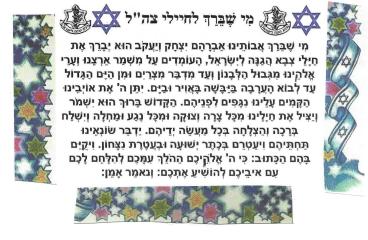This is another guest post by frequent contributor Brian Goldfarb. He addresses the tragic accidental killing by the IDF of 7 World Central Kitchen aid workers in Gaza – and it was indeed an accident no matter what the world thinks or says – or possibly a Hamas trap. Read on.

A Palestinian inspects near a vehicle where employees from the World Central Kitchen (WCK), including foreigners, were killed in an Israeli airstrike (credit: Ahmed Zakot/Reuters)
I would hope that we can all agree that the killing of the foreign aid workers in Gaza by the IDF (and admitted by them) is a tragedy that should never have happened. We should also note that either 2 or 3 (the numbers varies between reports that I have heard on the radio) senior officers have been relieved of their duties (at lest for the time being) presumably pending an inquiry/hearing/court martial. Which is as it should be. Here is an excerpt from the IDF investigation at the link above:
The investigation’s findings indicate that the incident should not have occurred. Those who approved the strike were convinced that they were targeting armed Hamas operatives and not WCK employees. The strike on the aid vehicles is a grave mistake stemming from a serious failure due to a mistaken identification, errors in decision-making, and an attack contrary to the Standard Operating Procedures.
After being presented with, and considering the investigation’s findings, the IDF Chief of the General Staff decided that the following command measures will be taken: the brigade fire support commander, an officer with the rank of major, will be dismissed from his position. The brigade chief of staff, an officer with the rank of colonel in reserve, will be dismissed from his position. Additionally, the brigade commander and the 162nd Division commander will be formally reprimanded. The IDF Chief of Staff decided to formally reprimand the commander of the Southern Command for his overall responsibility for the incident.
We can note that this procedure is standard across any number of armed forces in the democracies. Allow me here to digress (but it is relevant to this situation): while still employed as an academic, I had a colleague, some 10 years older than me, who had done National Service in the UK army. He had been stationed in Hong Kong as Headquarters company clerk in the early 1950s. One of his duties was to accompany any army patrol that was sent out to deal with any riots that occurred. As such, he had to record exactly what happened including any orders the officer in charge gave. If the officer felt it necessary to order shots to be fired (whether in the air or at rioters), on returning to barracks he placed himself under open arrest, pending an inquiry. In many former British colonies, the armed forces still follow this practice: it is part of their version of what in Britain is called “Queen’s/King’s Regulations”.
I understand that he same is true of the IDF, and some version of this is what has happened to the IDF officers concerned, and the statement that the markings on the vehicles in which the aid workers were travelling were not as clearly identifiable as they should have been may be true, but does not necessarily excuse the resulting action.
However, and it is a massive however, the response of many in the media demanding that Israel and the IDF immediately scale back their efforts to consign Hamas to the dustbin of history so that this doesn’t happen again is to demand that Israel and the IDF effectively declare that Hamas have won. What this does, especially if the IDF were to do as these commentators demand, from the safety of their studios in unwar-torn Europe and North America, is to say that October 7 didn’t happen, or that it is irrelevant to what came after. It is to deny the reality of the last 6 months.
So, let’s go back six months. Who started this war? Did Israel attack itself on October 7 and say Hamas did it, so that the IDF could enter Gaza and start to flatten it? Yes.of course that last sentence is nonsense: Hamas did start this war and have stated, openly and often, that they would wish to do the same again and again and…Which is why the IDF is doing what it is in Gaza, so that Hamas can’t do it again and again, or at least not for a significant number of years. And in war, there are unintended consequences, at least by those responding to the aggression of others.
Let me take some examples, which are chewed over again and again (with no consensus as to the “proper”or “right”answer) from World War Two: the bombing of Dresden and the atomic bombs dropped on Hiroshima and Nagasaki.
First of all, who started the war in Europe, the Western Allies and Russia or Nazi Germany? Okay, we all know the answer to that one. Does that justify the virtual destruction of Dresden? There are those who argue that Dresden had no strategic significance, and thus the bombing was, in effect, a terror attack, made worse by the fact that many domestic buildings in Dresden were built of highly flammable materials. Others counter-argue that Dresden was a railhead, vital for supplying the German troops in Eastern Europe and Russia. But it was wartime, and total war at that.
Either way, it wasn’t the Republicans who, during the Spanish Civil War, bombed Guernica (a Republican city) but the German/Nazi Condor Legion: a foretaste of what the Luftwaffe would do to Amsterdam, London, Coventry and many other British cities.
Then there is my other case: again, who started the war in the Pacific? Did the Americans provoke the Japanese with acts of aggression? And before anyone comes up with some crazy conspiracy theory, the answer is no: the attack on Pearl Harbour was a totally unprovoked attack on a non-combatant in World War Two. Does that justify the dropping of the atom bombs on Hiroshima and Nagasaki? The general counter-argument is that without the A-Bombs, invading the Japanese Home Islands would have probably cost at least half a million allied troops lives, to say nothing of the cost in civilian lives in those islands. There are those who accept this argument, but suggest that the second bomb (on Nagasaki) was superfluous, because the Japanese were close to surrender after the first bomb.
Whether or not these counter-arguments are accepted, the major point is that in every case I’ve cited, it is the victims of the initial aggression who are being held to account for what might well be excessive responses or even genuine mistakes. And thus the fact that these are responses and not initial acts of aggression is of great importance. We always need to remember that the law relating to war and fighting between two powers short of formal war states unequivocally that a sufficient and proportional response to aggression directed towards a sovereign society by another organisation, whether a state or a non-state actor, is such as to stop the aggressor: not a bullet for a bullet, etc, but sufficient to stop them. In the case of Hamas (and similar terrorist organisations : are you listening, Nasrallah of Hezbollah), what the IDF are doing may well, with occasional (and they are occasional) slippages, come comfortably under this umbrella of “proportional responses”.
The eminent commentator on these matters, Natasha Haussdorf of UK Lawyers for Israel, believes so: do look out for her comments on these matters.
Here is a video of Natasha Haussdorf addressing the charges of genocide against Israel:
Anne adds:
Brian, thank you for an excellent description and backgrounder of the reality of “collateral damage” and who is to blame for it in the context of war.
First of all I would advise everyone to read the Jerusalem Post article that I linked to at the top, it shows how Hamas deliberately acted to confuse the IDF and its drone operators, and lured them in to deliberately target the innocent aid workers. Here is the relevant extract:
The drone unit saw multiple suspicious actions, starting after 10 p.m. Monday.
First, the drone unit said it saw a Hamas terrorist climb onto one of the trucks and fire in the air at what it called action point two.
According to the IDF, this tactic is frequent and is used by Hamas to send signals to other Hamas fighters in the area regarding his position.
At action point three, the convoy split up.
At action point four, the convoy entered a hangar, which obscured which vehicles might be going in and out and who might be in the vehicles compared to who was in the vehicles before entering the hangar.
IDF unable to reach aid workers
In the first four action points, the IDF drone unit refrained from attacking the aid trucks, because they questioned their commanders and were ordered by Division 162 Brig. Gen. Itzik Cohen not to, despite a suspicion of Hamas terrorists being involved. IDF tried to call aid workers, was unable to reach them.
At the fifth action point, the aid trucks had left the hangar.
As the events developed, the IDF tried to call the aid workers involved in the field and was unable to reach them.
Next, the IDF called the WCK headquarters. The WCK headquarters tried to call its own aid workers in the field, but they did not answer.
When vehicles left the hangar, the IDF drone unit believed that these were not the same vehicles and thought that these were Hamas vehicles or that around four Hamas operatives had joined or taken over the convoy.
According to the IDF, attacking the trucks after all of this was a mistaken identity issue but could not lead to criminal charges.
Accordingly, the drone unit believed the order not to attack no longer applied.
Around a kilometer later, around 11:09 p.m., the drone unit believed it had the right to engage the trucks.
Also, the drone unit had thermal imaging that did not see the WCK aid worker sign posted on the roof of the trucks.
When the drone unit attacked three separate times in succession, it believed that the “coast was clear” completely to attack what it thought were clearly Hamas targets.
As one commentator on Twitter wrote, “Hamas are playing the West like a violin”.
I have also come across a couple of excellent articles in the British press on this very issue and I highly recommend you all read them and share them widely.
From the Spectator: The truth about Israel’s “friendly fire” by the always excellent Brendan O’Neill. A snippet:
It seems Israel is the only state not allowed to make mistakes. Where us decent Westerners kill friends in error, Israel does it intentionally, with malice at its heart. The double standards are staggering. It is hypocritical and ridiculous for the citizens of nations that have accidentally killed far more people than Israel to now lecture Israel about its wayward bombs.
It smacks of bigotry, too. We make mistakes, they commit crimes. We err, they murder. We should be forgiven, they should not. There’s an ironically neocolonialist bent to this fury with Israel, for it bigs up the West, despite its history of war crimes, as a suitable judge and jury of that uppity little state over there.
From the Daily Mail: The double standards in war are nauseating, by Richard Littlejohn:
An estimated 300,000 Iraqi civilians were killed after the 2003 Anglo-American invasion, and although there was widespread opposition to the war I don’t recall anyone credibly accusing the British or U.S. governments of committing ‘genocide’.
In 2011, a NATO-led bombing campaign in Libya, enthusiastically endorsed by then Prime Minister David Cameron, claimed countless innocent lives. After the fall of Colonel Gaddafi, Call Me Dave even went on a victory parade in Tripoli.
Yet today, the now Lord Cameron is condemning Israel over its actions in Gaza and demanding a ‘full, transparent explanation’.
…
Both Cameron and Biden can legitimately be accused of self-serving hypocrisy, aimed at restoring their own, tarnished wartime reputations and, in the case of the U.S. President, seeking electoral advantage by sucking up to Muslim voters in swing states such as Michigan.
When British or U.S. troops accidentally kill innocent civilians, journalists or aid workers it’s ‘friendly fire’ in the heat of battle. When Israel does likewise, it’s a deliberate war crime. The double-standards are nauseating.
To summarise my own feelings on this tragedy, I get the strong feeling that the world, yes, even Israel’s ostensible allies in the West, have been standing in the wings almost drooling, waiting for Israel to make a mistake. Yes, the IDF killed 3 of our own hostages accidentally, but that doesn’t count because they are not “innocent Palestinians”. But FINALLY, the IDF did what everyone has waited for. They killed 7 aid workers. And the world pounced with glee.
I know I am exaggerating slightly but I simply cannot avoid this awful sensation of the world just waiting in fevered anticipation of Israel making a deadly mistake. It doesn’t matter that this has finally happened after 6 months of intense urban warfare, no one cares a hoot. And despite the casualty figures (where the Palestinian casualties cannot be relied upon since they were provided by the terrorists themselves), even if you relied on the fictitious numbers provided by Hamas, the civilian to combatant ratio is incredibly low, lower than any other army has achieved in war.
On this very subject – the charges that the IDF is killing civilians, read this article by war historian and military expert John Spencer in Newsweek: Israel has created a New Standard for Urban Warfare:
In their criticism, Israel’s opponents are erasing a remarkable, historic new standard Israel has set. In my long career studying and advising on urban warfare for the U.S. military, I’ve never known an army to take such measures to attend to the enemy’s civilian population, especially while simultaneously combating the enemy in the very same buildings. In fact, by my analysis, Israel has implemented more precautions to prevent civilian harm than any military in history—above and beyond what international law requires and more than the U.S. did in its wars in Iraq and Afghanistan.
The international community, and increasingly the United States, barely acknowledges these measures while repeatedly excoriating the IDF for not doing enough to protect civilians—even as it confronts a ruthless terror organization holding its citizens hostage. Instead, the U.S. and its allies should be studying how they can apply the IDF’s tactics for protecting civilians, despite the fact that these militaries would almost certainly be extremely reluctant to employ these techniques because of how it would disadvantage them in any fight with an urban terrorist army like Hamas.
And that is in the end what angers and frustrates me to tears – the unfairness of it all, the lack of logic, the lack of historical analysis, and the pandering to the extremists in Western populations.
But we shall continue, and we shall fight on to victory because we have no other choice.
!עם ישראל חי












